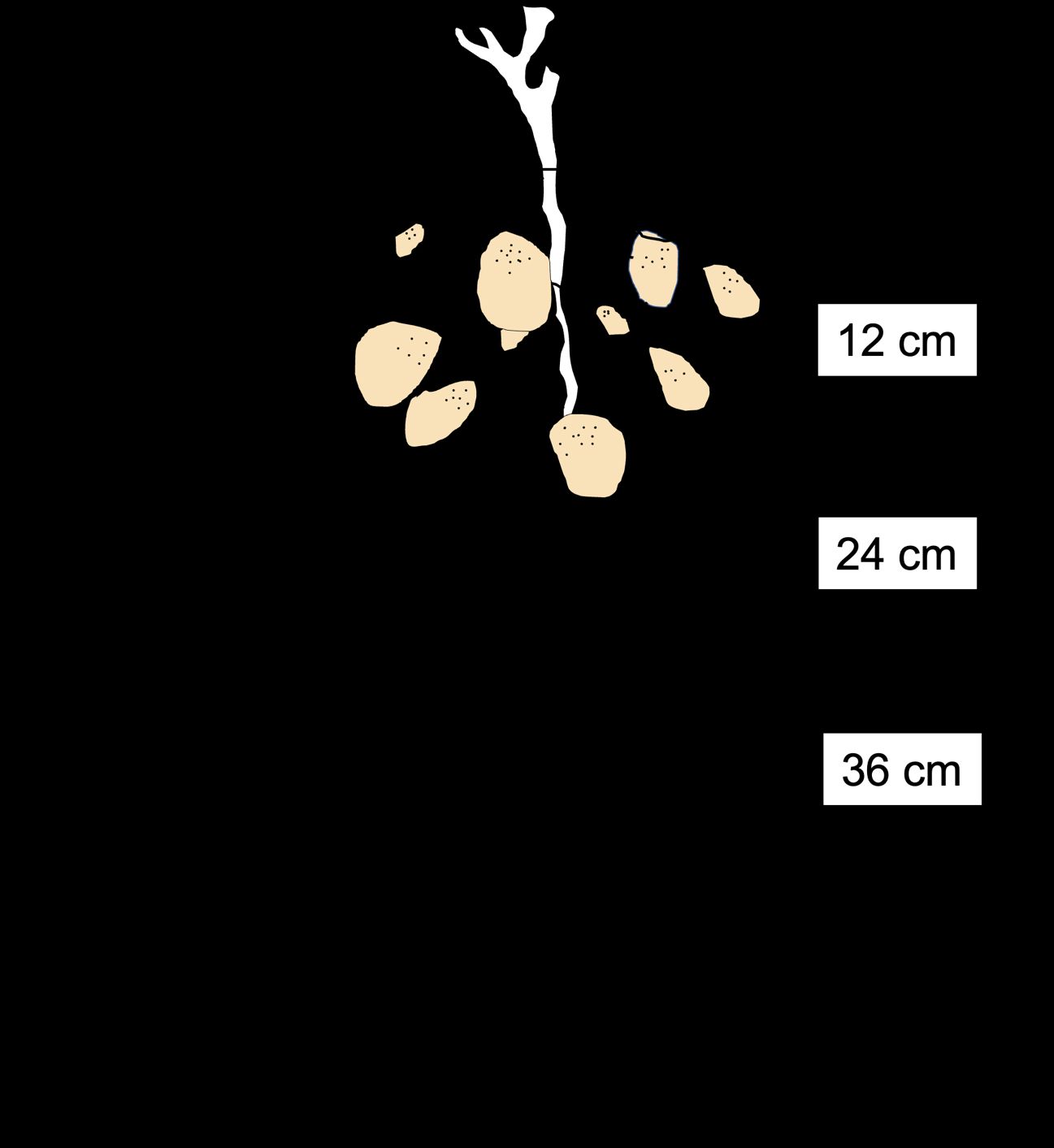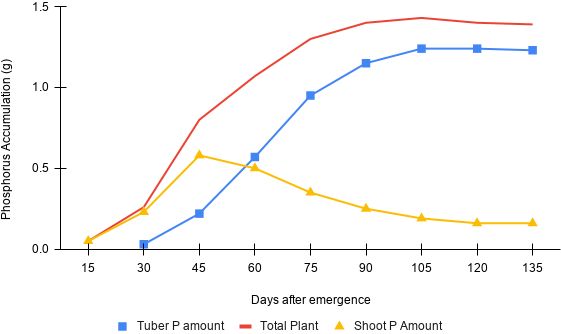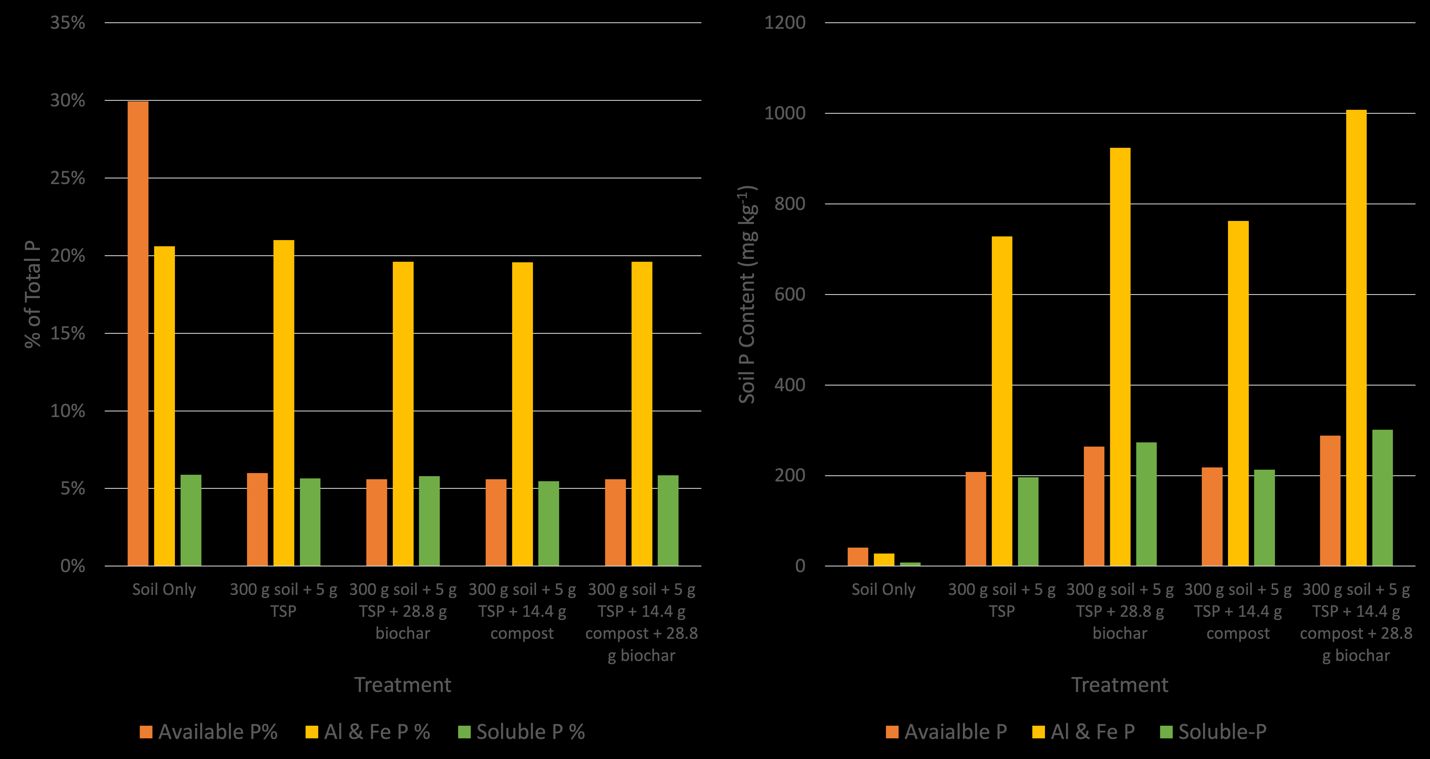Aim
This article is for Extension agents and potato growers. It aims to present the importance of phosphorus in the production of potatoes in Florida and highlight the soil phosphorus levels, phosphorus needs, and best phosphorus management practices for potato production in northeast Florida.
Introduction
In 2019, the average American consumed 37.6 kg of potatoes—a 2.73 kg increase from potato consumption in 2009 (USDA 2020b). Florida grew 1.64% of the total U.S. potato crop, making it the 13th largest producer in the country (USDA 2020a). Spring potatoes are a valuable crop to farmers in Florida due to their high relative value. One of only two spring potato producers (with CA) in 2020, Florida and its yields accounted for 31% of the country’s spring potato crop (USDA 2020b). Only two states producing spring potatoes meant a decreased supply as demand remained relatively constant. This led to higher prices for spring potatoes, FL having the highest potato crop value out of any state at $469.67 per ton (USDA 2020a). This high value incentivized farmers to plant 4,258 hectares of potatoes in 2019 with a total yield of 45,483,521 kg (USDA 2020a). Though the total yield has decreased since 2015, farmers have become more efficient, increasing their yields from 28,021 kg ha-1 to 30,823 kg ha-1 (USDA 2020a). In total, Florida produces $125 million dollars’ worth of potatoes a year, making it the state’s fifth largest crop. 80% of the crop in Florida is produced in the Tri-County Agricultural Area (TCAA), located in northeast Florida (Hochmuth & Cordasco 2008).
Potatoes have a low phosphorus use efficiency, meaning that high amounts of P amendments need to be added each season. These P amendments can account for 20–30% of the total production costs for potatoes (Hopkins 2013). It has been reported that farmers still apply extra P as a form of cheap crop-insurance, despite their higher costs (Hochmuth et al. 2002). Annually, these extra P additions have also led to increased legacy P levels in the area with mehlich-1 levels as high as 375 mg kg-1 (Hochmuth et al. 2002). The high input costs and soil P levels indicate that alternative P management strategies may be necessary to improve P use efficiency (PUE), reduce fertilizer costs for farmers, and minimize environmental impacts.
Soil Phosphorus
Potatoes have a relatively low P removal rate of 25–45 kg ha-1 but currently receive 112 kg P2O5 ha-1 indicating a low PUE (Thornton et al. 2014; Liu et al. 2020; Mikkelsen 2015). Current fertilizer recommendations for the region are based on Mehlich-3 soil P levels. These fertilizer recommendations call for 112 kg P2O5 ha-1 for levels below 45 mg kg-1 and for 134 kg P2O5 ha-1 for levels below 25 mg kg-1 (Liu et al. 2020; Mylavarapu et al. 2017). However, these recommendations do not call for any P2O5 if the soil levels are above 45 mg kg-1, which is common in the TCAA. Farmers typically apply P fertilizer one month before planting. Research has shown that during that month, 85% of the P is fixed in mineral and organic fractions, leading to a buildup in legacy P; only 15% is absorbed by the plants (Liao et al. 2015). This buildup in legacy P has led to Mehlich-3 soil P levels of 26–475 mg kg-1 (Hochmuth et al. 2002). These levels can be a full magnitude above the critical P value for growth (30–35 mg kg-1) (Hochmuth & Cordasco 2008; Rosen et al. 2014; Hochmuth et al. 2002) and well above the value for runoff (75–200 mg kg-1) (Sharpley et al. 1996). Though the current P levels indicate that P applications are not necessary to maintain yields, farmers in the region still report observing higher yields with additional P inputs.
It is important to follow regional P fertilizer recommendations to maximize yields; potatoes’ response can depend on climate, cultivar, diseases, and fertilizer placement, all of which are regional concerns (Rosen et al. 2014). Recommendations also can vary depending on temporal scales. In 1960, the newly cleared soils in the TCAA had low P levels and required 448 kg P2O5 ha-1. In 2008, the required level was decreased to 135 kg ha-1 for soils with Mehlich-1 soil P levels below 30 mg kg-1 (Hochmuth and Cordasco 2008). Research by Setu and Mitku (2020) in Ethiopia found no difference in yields on plots with low soil P levels (8.23 mg kg-1) which received varying P treatments: from 0 to 200 kg P2O5 ha-1. In contrast, it is recommended that 73-112 kg ha-1 of P is used in Wisconsin for soils with Bray 1 soil P levels between 61–90 mg P kg-1 (Ruark, Kelling, and Good 2014). These studies indicate the importance of adapting soil P measurement methods and applications based on the region and of reviewing these practices regularly to adapt any changes in the region.
Phosphorus Uptake in Potato Plants
During the 1980–81 growing season, potatoes were observed to have an uptake rate of 34–45 kg P2O5 ha-1 (Hochmuth and Cordasco 2008). Since then, multiple studies have observed increased P concentrations in potato plant tissues in conjunction with increased fertilizer rates. This indicates that P uptake rates may have increased with the change in soil P levels and fertilizer recommendations (Fernandes et al. 2017; Little, Hocking, and Greene 2004; Fernandes and Soratto 2012; Soratto et al. 2015). Due to the increases in P levels in soil, new research would be valuable in quantifying any changes in P uptake rates over the past 40 years. Potatoes have a low PUE due to the rooting depth, distribution, and root hair composition (Figure 1).

Credit: Van Zeghbroeck et al. 2021
In low P soils, root hairs can be responsible for up to 90% of P uptake (Thornton et al. 2014). Most crops have a root hair percentage between 30%–60%, but potatoes have much lower levels at only 21% (Thornton et al. 2014). Additionally, 90% of a potato’s root mass is in the top 25 cm of the soil; and the highest density of roots is present at a depth of 12 cm–15 cm (Hopkins et al. 2014; Munoz-Arboleda 2006). After 60 to 90 days of potato crop growth, the root system and crop canopy stop developing and begin to decay (Figure 2) (Thornton et al. 2014). During this second phase, the plant remobilizes and translocates nutrients to other parts of the plants, such as tubers; in doing so, the P concentrations in the above ground plant decrease by 95% (Kolbe and Tepha-Beckman 1997; Thornton et al. 2014). By the end of this phase the P concentration is 35% higher in the tuber than the vegetative tissue despite the vegetative tissue having higher total nutrient concentrations (Hochmuth and Coradsco 2008). This suggests that P is translocated more than other nutrients and that early season P uptake is essential to tuber production later in crop growth.

Credit: Van Zeghbroeck et al. 2021; Data Source: Kolbe and Stephan-Bekmann 1997
The root physiology and life cycle combined with the soil P dynamics highlight the importance of the proper placement and timing of P applications in potato production in the TCAA. Research conducted by P. Munoz-Arboleda (2008) found that fertilizer placed directly above or 5 cm below the seed piece can maximize the root length density and specific root length of a potato crop. Applying P early in the growing season has been shown to be more beneficial than mid-season applications, helping ensure nutrient requirements are met during the period of max P uptake (Kelling et al. 2020). Split P applications, through fertigation, can significantly increase the leaf area index (LAI) and P uptake in the middle and end stages of the potato growth (Cui et al. 2020). Arbuscular mycorrhizal fungi (AMF) can also benefit the short-rooted potato: building AMF communities in the soil increases P uptake during the early stages of crop growth (Grant et al. 2005), which can ensure sufficient P levels for juvenile plant growth while reducing overall P applications (Bittman et al. 2006). AMF communities can be inhibited when soil nutrient levels exceed the needs of the plant. Thus, nutrient levels should not exceed plant requirements to ensure healthy AMF development (Grant et al. 2005).
Fertilizers, Soil Amendments, and Management Strategies
A variety of mineral P fertilizers are commonly used in potato production including normal (ordinary) superphosphate (20% P), triple (concentrated) superphosphate (46% P), diammonium phosphate (46% P), and monopotassium phosphate (53% P) (Simonne and Hochmuth 2005). Mineral fertilizers can add a high amount of total P to the soil but are broad spectrum and do not solely increase bioavailable P in the soil or the P available long-term. Increased levels of labile P in the soil can be an issue in Florida potato production due to the already high soil P levels and risk for P losses.
Research has been conducted on organic amendments that may be able to increase the bioavailable P while adding less total P to the soil. Bone meal has the highest P2O5 concentration (22%) out of organic fertilizers, with most having a concentration of 5% or less (Simmone and Hochmuth 2005). Organic amendments, including biochar from chicken manure and composted pineapple leaves, can fix Fe and Al in the soil, reducing the immobilization of P into a mineral bound form (Figure 3) (Ch’ng et al. 2014). Humic acid, when combined with chemical fertilizers, can increase PUE in potato production by 34.2%—i.e., 6.4% higher than PUE increase by chemical fertilizer alone (Selladurai and Purakayastha 2016). Fodder rape and white lupin, which are scavengers or have P releasing characteristics, were used in potato systems in New South Whales; the two increased the P content in potatoes by increasing the effectiveness of fertilizers (Little et al. 2004).

Credit: Van Zeghbroeck et al. 2021; Data Source: Ch’ng et al. 2014
Several new fertilizers focus on increasing PUE by reducing mineral fixation in the soil and keeping P in a bioavailable form (Hopkins 2013). A new fertilizer called AVAIL® was designed to be used with mineral fertilizers to extend the P solubility past the midpoint of the growing season. It led to increased yields and P concentrations in the plant material (Hopkins 2013). However, research results on new products were mixed; 20% of the time, AVAIL® showed decreased yields, indicating the need for more research on the efficacy of these products (Hopkins 2013). Grow Glow 45H combines humic acid with multinutrient fertilizers to increase PUE; the product has been shown to increase yields, PUE, and P concentrations in the shoots and tuber more so than mineral fertilizers (Selladurai and Purakayastha 2016).
Conclusion
The high value of Florida’s spring potato crop has made it an important crop for growers despite the costs of ensuring adequate soil P levels. In order to ensure yields each year, farmers apply P fertilizer even when soil P levels are well above the soil P levels recommended by IFAS. Repeated applications have led to a build-up of legacy P to levels as high as 475 mg kg-1 Mehlich-3 P—levels which are a magnitude higher than critical P values of 30-35 mg kg-1. This poses a potential environmental concern and increases the risk of P losses polluting nearby waterways. The fact that P is fixed to minerals in the soil—minerals that are unavailable to the shallow root-structure and low root hair percentage of potatoes—likely causes farmers’ perception of a continual need to apply fertilizer. However, more research needs to be conducted in the region to identify the factors impacting P availability.
Current P fertilizer programs in Florida recommend a single application 30 days before planting. The amounts are based on potato P requirements and soil P levels; but these amounts do not appear to consider that up to 80% of the available P may be fixed by minerals in the soil, becoming unavailable to crops by the time of planting. Alternative fertilizer and management programs may be able to address some of these challenges by improving the timing of P applications and by fixing Fe and Al to keep higher levels of P in bioavailable forms. The use of organic fertilizers—including biochar, compost, and humic acid—have the potential to increase bioavailable P. Additionally, the use of new fertilizers that focus on maximizing P efficiency may be able to reduce P application rates. More research needs to be done on how these fertilizers respond to the mineral soils found in the TCAA before new recommendations can be made. Management strategies can also play an important role with cover cropping displaying an ability to increase P availability. Farmers and researchers should work together to test out new fertilizer and management strategies for potatoes in the TCAA; this collaboration would help identify ways to maximize P applications, reducing environmental impacts on the surrounding areas and costs for farmers.
References
Bittman, S., C. G. Kowalenko, D. E. Hunt, T. A. Forge, and X. Wu. 2006. “Starter Phosphorus and Broadcast Nutrients on Corn with Contrasting Colonization by Mycorrhizae.” Agronomy Journal 98(2): 394–401. https://doi.org/10.2134/agronj2005.0093.
Ch’ng, H. Y., O. H. Ahmed, and N. M. A. Majid. 2014. “Improving Phosphorus Availability in an Acid Soil Using Organic Amendments Produced from Agroindustrial Wastes.” The Scientific World Journal 2014: 16. https://doi.org/10.1155/2014/506356.
Cui, S., Y. Qin, J. Yu, X. Shi, L. Jia, and M. Fan. 2020. “Improving Tuber Yield and Phosphorus Use Efficiency Using Split Phosphorus Application to Potatoes in Inner Mongolia.” American Journal of Potato Research 97: 318324. https://doi.org/10.1007/s12230-020-09783-3.
Fernandes, A. M. and R. P. Soratto. 2012. “Nutrition, Dry Matter Accumulation and Partitioning and Phosphorus Use Efficiency of Potato Grown at Different Phosphorus Levels in Nutrient Solution.” Revista Brasileira de Ciência do Solo 36(5): 15281537. https://doi.org/10.1590/S0100-06832012000500017.
Fernandes, A. M., R. P. Soratto, E. F. C. Souza, and A. L. G. Job. 2017. “Nutrient Uptake and Removal by Potato Cultivars as Affected by Phosphate Fertilization of Soils with Different Levels of Phosphorus Availability.” Revista Brasileira de Ciência do Solo 41: 123. https://doi.org/10.1590/18069657rbcs20160288.
Grant, C., S. Bittman, M. Montreal, C. Plenchette, and C. Morel. 2005. “Soil and Fertilizer Phosphorus: Effects on Plant P Supply and Mycorrhizal Development.” Canadian Journal of Plant Science 85(1): 314. https://doi.org/10.4141/P03-182.
Hochmuth, G., and K. Cordasco. 2008. “A Summary of N, P, and K Research on Potato in Florida: HS756.” EDIS 2008 (4): 1–22. https://ucanr.edu/sites/nm/files/76620.pdf.
Hochmuth, G., P. Weingartner, C. Hutchinson, A. Tilton, and D. Jesseman. 2002. “Potato Yield and Tuber Quality did not Respond to Phosphorus Fertilization of Soils Testing High in Phosphorus Content.” HortTechnology 12(3): 420–423. https://doi.org/10.21273/HORTTECH.12.3.420.
Hopkins, B. G. 2013. “Russet Burbank Potato Phosphorus Fertilization with Dicarboxylic Acid Copolymer Additive (AVAIL®).” Journal of Plant Nutrition 36(8): 1287–1306. https://doi.org/10.1080/01904167.2013.785565.
Hopkins, B. G., D. A. Horneck, and A. E. MacGuidwin. 2014. “Improving Phosphorus Use Efficiency through Potato Rhizosphere Modification and Extension.” American Journal of Potato Research 91(2): 161–174. https://doi.org/10.1007/s12230-014-9370-3.
Kelling, K. A., R. P. Wolkowski, P. E. Speth, and T. W. Andraski. 2020. “Interaction of Fertilizer Phosphorus Rate and Placement/Timing on Potatoes.” American Journal of Potato Research 97(4): 420–431. https://doi.org/10.1007/s12230-020-09784-2.
Kolbe, H., and S. Stephan-Beckmann. 1997. “Development, Growth and Chemical Composition of the Potato Crop (Solanum tuberosum L.). I. Leaf and Stem.” Potato Research 40: 111–129. https://doi.org/10.1007/bf02407567.
Liao, X., G. Liu, B. Hogue, and Y. Li. 2015. “Phosphorus Availability and Environmental Risks in Potato Fields in North Florida.” Soil Use and Management 31(2): 308–312. https://doi.org/10.1111/sum.12186.
Little, S. A., P. J. Hocking, and R. S. B. Greene. 2004. “A Preliminary Study of the Role of Cover Crops in Improving Soil Fertility and Yield for Potato Production.” Communications In Soil Science and Plant Analysis 35(34): 471–494. https://doi.org/10.1081/CSS-120029726.
Munoz-Arboleda, F., R. S. Mylavarapu, C. M. Hutchinson, and K. M. Portier. 2006. “Root Distribution under Seepage-Irrigated Potatoes in Northeast Florida.” American Journal of Potato Research 83(6): 463472. https://doi.org/10.1007/BF02883507.
Rosen, C. J., K. A. Kelling, J. C. Stark, and G. A. Porter. 2014. “Optimizing Phosphorus Fertilizer Management in Potato Production.” American Journal of Potato Research 91(2): 145160. https://doi.org/10.1007/s12230-014-9371-2.
Ruark, M. D., K. A. Kelling, and L. W. Good. 2014. “Environmental Concerns of Phosphorus Management in Potato Production.” American Journal of Potato Research 91(2): 132–144. https://doi.org/10.1007/s12230-014-9372-1.
Selladurai, R. and T. J. Purakayastha. 2016. “Effect of Humic Acid Multinutrient Fertilizers on Yield and Nutrient Use Efficiency of Potato.” Journal of Plant Nutrition 39(7): 949–956. https://doi.org/10.1080/01904167.2015.1109106.
Setu, H. and T. Mitiku. 2020. “Response of Potato to Nitrogen and Phosphorus Fertilizers at Assosa, Western Ethiopia.” Agronomy Journal 112(2): 1227–1237. https://doi.org/10.1002/agj2.20027.
Sharpley, A., T. C. Daniel, J. T. Sims, and D. H. Pote. 1996. “Determining Environmentally Sound Soil Phosphorus Levels.” Journal of Soil and Water Conservation 51(2): 160–166. https://login.lp.hscl.ufl.edu/login?url=https://www.proquest.com/scholarly-journals/determining-environmentally-sound-soil-phosphorus/docview/220969749/se-2?accountid=10920.
Simonne, E. H. and G. J. Hochmuth. 2019. “Soil and Fertilizer Management for Vegetable Production in Florida: HS711/CV101, Rev. 11/2006.” EDIS 2006: 3–15. https://doi.org/10.32473/edis-cv101-2006.
Soratto, R. P., C. Pilon, A. M. Fernandes, and L. A. Moreno. 2015. “Phosphorus Uptake, Use Efficiency, and Response of Potato Cultivars to Phosphorus Levels.” Potato Research 58(2): 121–134. https://doi.org/10.1007/s11540-015-9290-8.
Thornton, M. K., R. G., Novy, and J. C. Stark. 2014. “Improving Phosphorus Use Efficiency in the Future.” American Journal of Potato Research 91(2): 175–179. https://doi.org/10.1007/s12230-014-9369-9.
USDA, National Agriculture Statistics Services. 2020a. Potatoes 2019 Summary. ISSN: 1949–1514.
USDA, National Agriculture Statistics Services. 2020b. Agricultural Statistics 2019.
Van Zeghbroeck, J., G. Liu, R. S. Mylavarapu, and Y. C. Li. 2021. “Phosphorus Management Strategies for Potato Production in Florida: a Review.” American Journal of Potato Research 98: 347–360. https://doi.org/10.1007/s12230-021-09851-2.
Worthington, C. M. and C. M. Hutchinson. 2005. “Accumulated Growing Degree Days as a Model to Determine Key Developmental Stages and Evaluate Yield and Quality of Potato in Northeast Florida.” In Proceedings of the Florida State Horticultural Society 118, edited by Ed Etxeberria, 98–101.